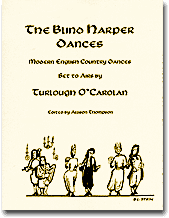 John O’Regan penned this review.
John O’Regan penned this review.
This book is at once fascinating and difficult to review. The fascination lies in the idea of combining the music of Turlough O’Carolan with modern English country dances. The difficulty lies in my own lack of experience in the world of choreography, which renders me unable to offer objective criticism or judgment to this project. Having said that, the work is an interesting collection in its own right.
Turlough O’Carolan (Toirdhealbhach Ó Cearbhalláin) was born in 1670 near Nobber, County Meath and died March 25, 1738 at the home of his patron Mrs. MacDermott Roe in Alderford, County Roscommon. His gift for composition and verse was his best suit, and the results lie in his tunes being recorded and played so often. As mentioned in many biographies of Turlough O’Carolan his interest in the Baroque and his friendship with Geminiani and Corelli outlined the fact that his musical nous lay far beyond the Irish world
Allison Thompson’s collection, The Blind Harper Dances, adds a further layer of possibilities to the use of O’Carolan’s music.The Blind Harper Dances takes a collection of popular O’Carolan pieces such as ‘Planxty Irwin’, ‘Fanny Power’, and ‘Hewlett’, to name but three, and choreographs newly composed country dances in the English country dance vein to the tunes. Though this as an idea is unusual and intriguing enough, the musical notation to each tune is also accompanied by line drawings of the steps and a run down of each dance.
The success of this project is in the visual stage. This is an interesting idea and one that cries out for an accompanying video or DVD for maximum results. It would be most interesting to see the dances enacted on DVD or video along with the tune. For then, one could rightly judge the success of the new dance in tandem with its source tune.
Dance fans and those interested in choreography ought to seek out The Blind Harper Dances for something different. In those hands this project is most suitable and successfully housed. Personally, I would like to see what reaction The Blind Harper Dances would arouse in a venue suitably renowned for country dancing such as London’s Cecil Sharp House. Then a better idea as to its success could be suitably ascertained.
(Squirrel Hill Press 2003)
